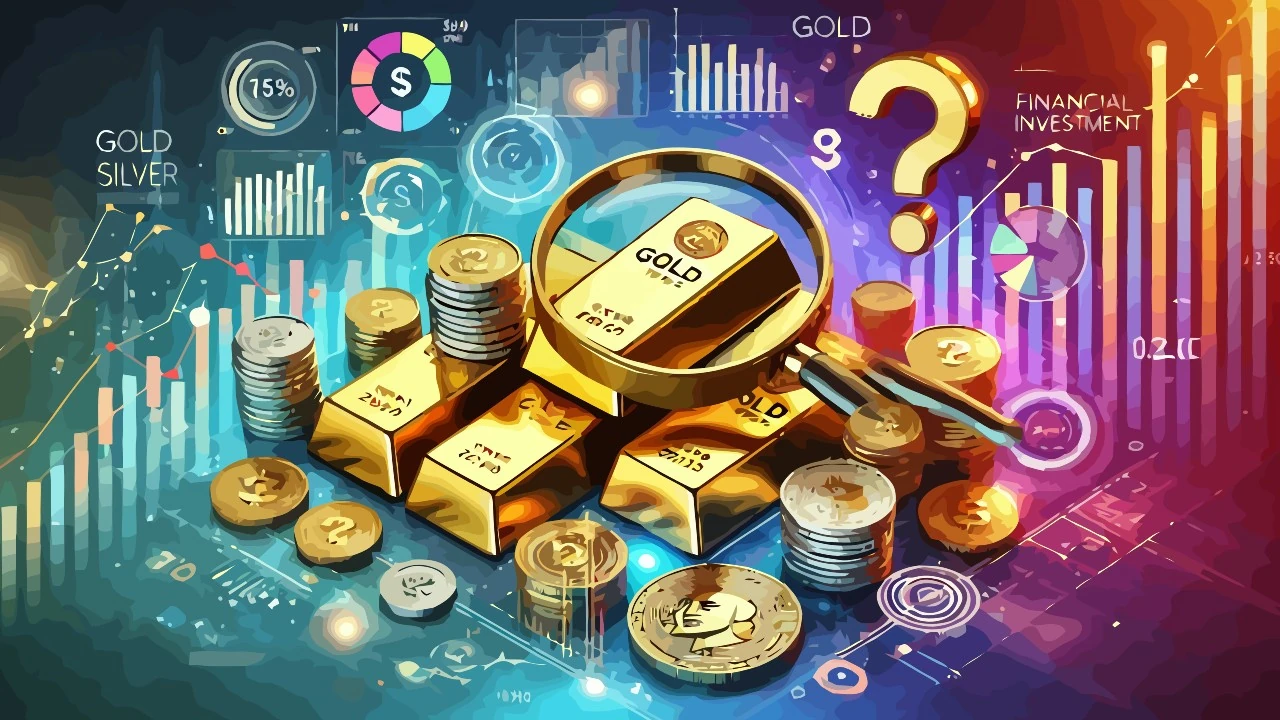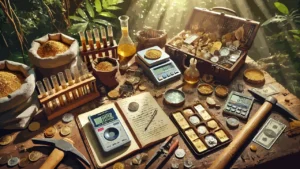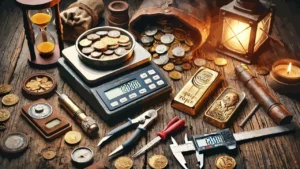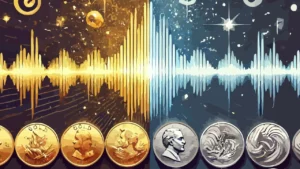This guide contains everything you need to know if you want to buy gold and silver coins, bars and ingots. Unless otherwise specified, the same things described apply to all precious metals.
Disclaimer:
The information provided does not constitute a solicitation for the placement of personal savings. The use of the data and information contained as support for personal investment operations is at the complete risk of the reader.
Contents
#1. Why buy gold? 💰
Gold has always occupied an important place in the minds of man. Since it was first used thousands of years ago as a medium of exchange, it has never lost this function.
The most significant episode was the encounter between the Spanish Conquistadors and the then indigenous people of Latin America. Both peoples, who had never come into contact with each other for millennia, attributed an uncommon value to objects made of gold. There is an innate quality in this metal for the human being.
Gold represents the ultimate safe haven and was the first successful form of money and currency for transactions on a local and global scale.
It protects purchasing power, is easily transportable and thanks to its high density can contain a large value in a small space: the value of a small house (about 3kg of gold) can fit comfortably in a woman’s handbag.
It is convertible anywhere in the world into local currency and is one of the most liquid material goods on the market. Thanks to its chemical properties, which make it immutable in any condition it is in, it can be stored without special precautions to ensure its preservation.
Contrary to what is often said, the applications of gold are constantly increasing and are increasingly being used in new technologies. However, the jewelry and investment sectors constitute more than half of the current use cases.
If you are looking for a good book, quite complete in dealing with this topic, I can recommend with my eyes closed Guide to Investing in Gold & Silver: Protect Your Financial Future by Michael Maloney which deals with investment gold and silver from different points of view in order to provide the reader with an overall vision touching on several crucial aspects.
👉 Read also: Nine Reasons to Choose Physical Gold
👉 Read also: The Value of Gold Inheritance
👉 Read also: Today, Compared to the Last Gold Rush of the 70s…
👉 Read also: Gold Price and Returns Over Time 📊
👉 Read also: Returns: Gold, Bonds and S&P 500 📊
Other precious metals
Silver, along with gold, is part of the monetary precious metals, but has many more industrial applications. Platinum and palladium, on the other hand, are non-monetary precious metals with almost exclusively industrial applications.
#2. Where to buy and sell gold? 💱
Gold can be purchased in many forms: coins, bars, jewelry, certificates, financial securities such as ETCs, and even in the form of cryptocurrency tokens. However, this guide focuses almost exclusively on physical gold, i.e. bars and coins.
Physical gold must be bought and sold exclusively at businesses accredited by the laws in force in the country in which you reside. It is highly inadvisable to turn to uncertified operators or unauthorized circuits, as you risk incurring scams or legal compliance issues.
Wherever you live, it is best to buy and sell gold directly in your country, since the price of gold is the same throughout the world. The idea of expatriating gold to sell it elsewhere is useless: the price of gold follows the same value everywhere. The most practical solution is to sell it in your country and then transfer the liquidity to the desired current account.
I have written a comprehensive and understandable guide to help you make the best decision:
👉 Read also: All the Possible Ways to Invest in Gold
#3. Coins, bars or plates? 💲
Gold is gold, in any form. The choice varies based on personal taste and/or how much you can spend in order to pay the lowest commission. Typically, the more you buy large pieces, the less commission you pay in proportion.
However, if we were to focus on paying the lowest possible commission, we would have to distinguish between “used” and “new” gold.
Difference between “used” and “new” gold
- “Used” gold is all gold, in the form of bars or coins, that the seller has purchased from other customers and currently holds in cash.
- “New” gold is all gold that the seller brings in in the form of bars or ingots packaged by a foundry or in the form of freshly minted coins from a mint.
If you buy used gold, you should pay a relatively low commission regardless of the format you are going to buy, as the seller has no third-party costs that increase the price. In fact, most likely, the latter has already made a profit as he has applied the negative margin to a customer-seller for the purchase of the gold itself.
If you buy new gold, however, the situation changes slightly as the seller will also have to cover third-party costs of foundries or mints, thus increasing the price per gram.
The question of the plates
Although less beautiful and less famous than coins and bars, gold plates are an excellent way to invest small amounts while paying low commissions on purchase. They have a millimetric thickness and are derived from the lamination of bars, i.e. bricks of raw gold resulting from casting in a mold called a stirrup, through a rolling mill.
Furthermore, given their millimetric thickness, it is relatively easier to proceed with the verification of their authenticity. This does not mean, however, that verifying coins, bars and ingots is difficult.
Personally, I would recommend buying “used” small denomination coins rather than the plaques. They may cost you slightly more than the latter but they come in a more appreciable format and are also more easily resold to private individuals, allowing you in this case to negotiate without an intermediary and therefore without commissions involved.
#4. What about numismatic gold? 🥇
By numismatic gold I mean all those objects in gold, especially coins, whose intrinsic value of the precious metal contained is accompanied by a premium, or additional value, almost always derived from historical events, manufacturing defects or limited runs.
For the purposes of investing in gold, it is irrelevant, indeed almost counterproductive, to buy numismatics. In fact, we must distinguish between investing and collecting:
- By investing you buy gold for the sole fact of wanting to own gold,
- By collecting: you buy gold to own particular coins or objects.
The problem with numismatic gold is that it costs more to buy and its market is decidedly less liquid than normal gold, paid for what it is worth at the time.
Even if any honest metal bank should always recognize the possible numismatic value of the gold you are going to sell, it is not a given that they will actually do so.
Finally, if you want to buy gold with numismatic value make sure you do not have to sell it in a hurry if necessary because some sellers might pay you only the actual gold content and not recognize its numismatic value.
#5. What is the right commission? 💳
Beware of Internet and YouTube sellers:
Over and over again I happen to see videos on the internet, and especially on YouTube, in which metal banks promote themselves as sellers of gold or silver coins or bars. Almost all of them have margins (that you discover only after contact) on the value of the precious metal much higher than those I suggest. Don’t make impulse purchases!
Commission or margin is the difference between the price of the gold content of a bar or coin and the total final price paid for that item. This difference is also commonly referred to as the “premium”.
The “premium” is essentially made up of 2 costs:
- Cost of manufacturing the bar or coin,
- Profit margin that the seller adds.
Commissions on gold
Bearing in mind what I have already said in section #3, I recommend sticking to the following rules if you intend to buy investment gold, not collectible gold or gold with a value that goes beyond the intrinsic value of the precious metal:
- If you buy “used” you should not pay > 4.5% compared to the gold content,
- If you buy “new” you should not pay > 7.5% compared to the gold content,
- If you sell you should not receive < 3% compared to the gold content.
These suggested margins, however, do not apply to numismatic gold, such as collector coins, whose premium over that of gold can rise significantly. On Numista.com you can find the sales results of some coins, so you can get an idea of what their actual current price might be.
Obviously these are the reference margins for small quantities: a few hundred grams. However, as the quantities increase, the commissions must decrease and can reach 1.5% if you buy or sell.
Do not forget that the value of the commission is also linked to the business relationship that is established between seller and buyer. A known customer and/or with certain buying and selling volumes will always have a favorable margin compared to another less known or that generates small buying and selling volumes.
Also keep in mind that, as a rule, metal banks in large cities can offer more advantageous margins on the price of gold than those in small cities or towns. This is because businesses with many customers also have more volumes and can consequently afford lower margins to be even more competitive.
Commissions on silver, platinum and palladium
For all other precious metals, however, expect slightly higher commissions than gold as they have a smaller market than the latter. Margins on purchase or sale can easily exceed 10%. They are also subject to VAT, but we will see this later.
Precisely for these reasons, if you wanted to buy a significant quantity of silver, platinum or palladium, perhaps it would be more convenient for you to buy them in the form of ETCs (physically covered). In fact, you will have very low purchase and sale commissions, immediate liquidity and in any case the taxation on the capital gain to which you would be subject is the same, current, of 26%.
#6. How to spot fake gold? 🔍
IIn general, both for gold and for all other precious metals for investment, these tests should be carried out:
Other tests for verification have been excluded because they are expensive, cumbersome or ruined. In any case, they would not be essential tests for the common person to authenticate investment metals.
I invite you to view the complete guide to verify investment gold and silver:
👉 Read also: How to Test Investment Gold and Silver 🎬
#7. Where to store gold? 🔒
Physical gold can be stored in basically 4 ways:
- At home, self-stored or with third parties
- Abroad, self-stored or with third parties
- In the form of financial securities
- In the form of cryptocurrency on blockchain
I have written a comprehensive and understandable guide to help you make the best decision:
👉 Read also: All the Possible Ways to Invest in Gold
#8. Can the gov confiscate gold? 💸
Yes, but it is a very remote hypothesis, at least as far as Italy is concerned. I think it is very unlikely that what happened in some States and in particular in the United States of America in 1933 could also happen in your country. To tell the truth, however, the famous “confiscation” was more of a bureaucratic act than a real seizure of gold from people’s homes.
👉 Read also: The Truth About the “Confiscated” Gold of 1933
However, today, most of the assets of most people are in the form of real estate, bank mutual funds, postal products, government bonds or cash in current accounts. Therefore, the risk of citizens having their gold confiscated for some sort of replenishment of gold reserves or “wealth tax” is very rare. In any case, even if this were to happen, confiscating gold is not as simple as making a forced withdrawal from current accounts or securities deposits.








Leave a Reply